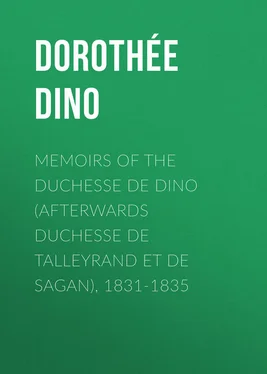Dino Dorothée - Memoirs of the Duchesse de Dino (Afterwards Duchesse de Talleyrand et de Sagan), 1831-1835
Здесь есть возможность читать онлайн «Dino Dorothée - Memoirs of the Duchesse de Dino (Afterwards Duchesse de Talleyrand et de Sagan), 1831-1835» — ознакомительный отрывок электронной книги совершенно бесплатно, а после прочтения отрывка купить полную версию. В некоторых случаях можно слушать аудио, скачать через торрент в формате fb2 и присутствует краткое содержание. Жанр: foreign_antique, foreign_prose, на английском языке. Описание произведения, (предисловие) а так же отзывы посетителей доступны на портале библиотеки ЛибКат.
- Название:Memoirs of the Duchesse de Dino (Afterwards Duchesse de Talleyrand et de Sagan), 1831-1835
- Автор:
- Жанр:
- Год:неизвестен
- ISBN:нет данных
- Рейтинг книги:4 / 5. Голосов: 1
-
Избранное:Добавить в избранное
- Отзывы:
-
Ваша оценка:
- 80
- 1
- 2
- 3
- 4
- 5
Memoirs of the Duchesse de Dino (Afterwards Duchesse de Talleyrand et de Sagan), 1831-1835: краткое содержание, описание и аннотация
Предлагаем к чтению аннотацию, описание, краткое содержание или предисловие (зависит от того, что написал сам автор книги «Memoirs of the Duchesse de Dino (Afterwards Duchesse de Talleyrand et de Sagan), 1831-1835»). Если вы не нашли необходимую информацию о книге — напишите в комментариях, мы постараемся отыскать её.
Memoirs of the Duchesse de Dino (Afterwards Duchesse de Talleyrand et de Sagan), 1831-1835 — читать онлайн ознакомительный отрывок
Ниже представлен текст книги, разбитый по страницам. Система сохранения места последней прочитанной страницы, позволяет с удобством читать онлайн бесплатно книгу «Memoirs of the Duchesse de Dino (Afterwards Duchesse de Talleyrand et de Sagan), 1831-1835», без необходимости каждый раз заново искать на чём Вы остановились. Поставьте закладку, и сможете в любой момент перейти на страницу, на которой закончили чтение.
Интервал:
Закладка:
I used to think Madame Dosne had the remains of beauty, but I thought on this occasion that she never could have been good looking. She has an unpleasing laugh, which is ironical without being gay. Her conversation is witty and animated, but her dress was pink and girlish, and affectedly simple to a degree which quite astonished me.
Paris, December 15, 1833. – Yesterday I dined with the King. M. de Talleyrand was dining with the Prince Royal. During dinner the King spoke of nothing but traditions and memories of the past and ancient castles. I was quite at home. First we exhausted the topic of Touraine: he promised stained glass and portraits of Louis XI. and Louis XII. for Amboise. He will buy back the remains of Montrichard, and will prevent the ruin of the Château de Langeais. If he does all this my dinner will not have been in vain! He then told me about the restorations he is having done at Fontainbleau, and ended by explaining to me his great plan for Versailles, which is really great and worthy of a great-grandson of Louis XIV. But will it come to pass? The conversation then turned on the new work which he has had done at the Tuileries themselves. He gave orders for the whole palace to be lit up, and after dinner he took me all through it.
Everything is really fine, very fine; and if the staircase, which is rich and elegant, were only a little broader, it would be quite perfect. This promenade took us from the Pavillon de Flore to the Pavillon de Marsan. Here the King asked me if I would like to pay a visit to his son, and I said, of course, that I would follow the King anywhere. We found the Duc d'Orléans playing whist with M. de Talleyrand, whose friends the Prince had invited to meet him.
The Prince's apartments are too beautifully furnished for a man's; that is the only criticism one can make, for they are full of lovely things found in the Royal garde-meuble, where all the fine pieces of the time of Louis XIV. were placed at the Revolution, and it did not occur to anyone at the time of the Restoration to take them out. The Duc d'Orléans has put a great many of them in his rooms. It is curious how often I have been at the Tuileries without ever suspecting the presence of the interesting things collected there. Thus, on this occasion in the King's room, among other things with which I was unfamiliar, I saw a portrait of Louis XIV. as a baby represented as a sleeping Cupid, and another of Anne of Austria as Minerva. I also saw some allegorical wood-carving of the time of Catherine de Medici, who built the Tuileries.
The King is an admirable guide to his palaces. I wondered during all our conversation how a man could know the traditions of his family so well and be so proud of them, and yet – . However!
I leave the day after to-morrow for London.
CHAPTER IV
1834
London, January 27, 1834. – Sir Henry Halford has just been telling me that the late King George IV., whose senior physician he was, asked him two days before his death to say on his word of honour whether the case was desperate. Sir Henry, with a significantly grave face, answered that his Majesty's condition was very serious; whereupon the King thanked him with a movement of his head, desired the Sacrament and communicated very devoutly, inviting Sir Henry to communicate along with him. Lady Conyngham was in the adjoining room. So no human interest was absent from the deathbed of the Royal charlatan while he partook of the Sacrament for the last time.
London, February 7, 1834. – Yesterday I was at Lady Holland's, who finished some story or other which she was telling me by saying, "I didn't get this from Lady Keith (Mme. de Flahaut), for she hasn't written to me for more than two months." Then she added, "Did you know that she hated the present Ministry in France?" "Of course," I answered; "it was you who told M. de Talleyrand all the nasty things she was saying here about the French Cabinet at the time when it was formed." "True," replied Lady Holland, "all the same, the Cabinet must be preserved. Lord Granville has written to Lord Holland to say that we must not believe everything Lady Keith says about the precariousness of the Duc de Broglie's position, for she is a bitter enemy of his and longs for his downfall." I said nothing, and the subject dropped. But, after this, don't speak to me of the friendships of this world!
Anyhow, they write rather amusingly of M. and Mme. de Flahaut from Paris, saying that their favour at the Tuileries is declining, he being considered a superannuated coquette, and she a foxy old intriguer.
Warwick Castle, February 10, 1834. – I left London the day before yesterday, and got as far as Stony Stratford, where I advise no one to pass the night. The beds are bad even for England, and I never experienced anything more like a trappist's couch. I left yesterday morning in the midst of a bitterly cold and extremely thick fog. It was impossible to get any idea of the country, which, however, from certain occasional glimpses, I believe to be rather pretty, especially about Iston Hall, a beautiful place owned by Lord Porchester. You pass a superb gate, from which there stretches a vast park, beyond which there is a view of a valley which seemed to me charming. Leamington, a few miles further on, is well built and cheerful.
As to Warwick itself, where I arrived yesterday morning, one enters by a fortress gate. Its aspect is the most severe, its courtyard the most sombre, its hall the most enormous, its furniture the most Gothic, and its style the most perfect that you can possibly imagine. Everything suggests the feudal system. A large and rapid river bathes the foot of the great dark old battlemented towers. The monotonous noise of the water is interrupted by the crackling of the great trees which burn in the gigantic fireplaces. In the hall huge logs are piled upon the dogs which stand on slabs of polished marble, and each log requires two men to put it on the fire.
I have only just glanced rapidly at the stained glass in the great broad windows, which are on the same scale as the fireplaces, at the armour and the antlers and the other curiosities of the hall, at the fine family portraits in the three great drawing-rooms. As yet I am only familiar with my own room, which is completely furnished with Boulle and carved walnut, and, in addition to these antique splendours, is full of all the modern comforts.
Lady Warwick's boudoir is also full of interesting things. She came to my room yesterday to fetch me, and after showing me the boudoir she took me to the little drawing-room, where we found Lord Monson, the son of her first marriage, a little man, or rather boy, shy and silent, and much embarrassed by the exiguity and weakness of his person. Lady Monson was also there. She is a striking contrast to her husband, being a tall blonde Englishwoman, stiff and bony, with long features and large hands, a great broad flat chest, angular in her movements, and rather like an old maid, but pretty and kindly. Here, too, was Lady Eastnor, the sister of Lady Stuart of Rothesay; ugly, like all her family, but well-bred, like all Lady Hardwicke's daughters. Lord Eastnor, a mighty hunter and a great eater and drinker, was also of the party; and his brother, a parson, who, I believe, has not shaved since Christmas, and who never opened his mouth except to eat. Lord Brooke, the son of the house, is fifteen and very nice looking; his tutor was with him, and was silent and respectful, as tutors should be. Finally, there was the striking figure of Lady Catherine Neeld, a sister of the Ashleys and a daughter of Lord Shaftesbury. She is celebrated for the suit she brought against her husband, of which all the papers were full last year. She is a friend of Lady Warwick's who protects, shelters, and defends her. She is a bold, rather loud person, with a malicious tongue and familiar and somewhat audacious manners. She is well made, has a white skin and beautiful fair hair, but neither eyebrows nor eyelashes. Her face is long and narrow; her eyes have no special merit, and her nose and mouth remind you of what Madame de Sévigné said of Madame de Sforze when she described her as being like "a parrot eating a cherry."
Читать дальшеИнтервал:
Закладка:
Похожие книги на «Memoirs of the Duchesse de Dino (Afterwards Duchesse de Talleyrand et de Sagan), 1831-1835»
Представляем Вашему вниманию похожие книги на «Memoirs of the Duchesse de Dino (Afterwards Duchesse de Talleyrand et de Sagan), 1831-1835» списком для выбора. Мы отобрали схожую по названию и смыслу литературу в надежде предоставить читателям больше вариантов отыскать новые, интересные, ещё непрочитанные произведения.
Обсуждение, отзывы о книге «Memoirs of the Duchesse de Dino (Afterwards Duchesse de Talleyrand et de Sagan), 1831-1835» и просто собственные мнения читателей. Оставьте ваши комментарии, напишите, что Вы думаете о произведении, его смысле или главных героях. Укажите что конкретно понравилось, а что нет, и почему Вы так считаете.












